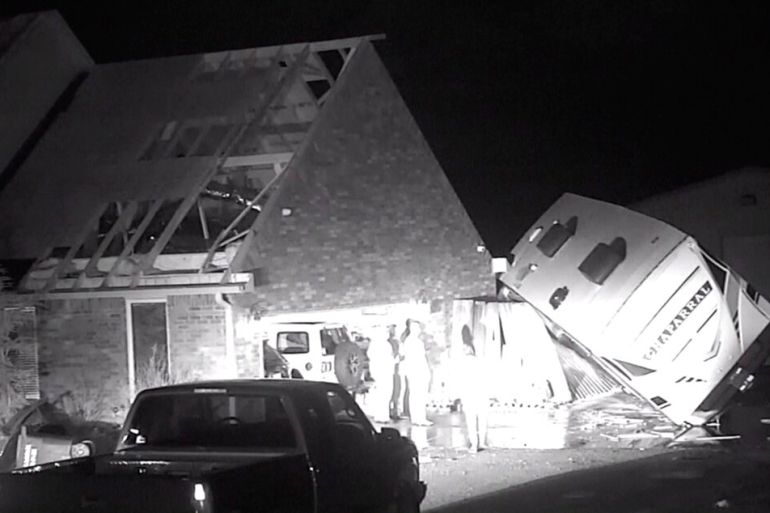Tornadoes sweep through central United States, knocking out power
Authorities urge caution as a series of winter storms continue to bring extreme weather across the US.

A series of tornadoes has lashed the central United States, leaving a trail of wreckage and injuries as winter storms continue to cause extreme weather around the country.
The National Weather Service reported nine tornadoes had swept through Kansas, Oklahoma and northwest Texas on Sunday night, flipping cars and bringing down trees and power lines. The fierce winds knocked out electricity for about 12,000 homes and businesses in Oklahoma, according to Poweroutage.us.
Keep reading
list of 3 itemsWinter storm lashes northern United States with snow, ice, wind
Historic snowfall expected as winter storm slams US Midwest
“I could hear the wind coming,” Frances Tabler, an Oklahoma resident, told the KOCO-TV station. “All of a sudden, all the back windows, where the kids’ bedrooms are, I could hear them just crashing, busting out. And I got up, and then the wind just threw me back, and I’m screaming.
“It was just like a blizzard in the house with all the debris flying. I was screaming for my kids.”
Authorities in the city of Norman, Oklahoma, reported at least 12 weather-related injuries, none of them critical. In other areas of the US, extreme weather has resulted in dangerous conditions, travel delays and damage to infrastructure.
In Michigan, a state in the Great Lakes region near Canada, ice storms have cut power to many residents over the past five days. According to Poweroutage.us, more than 130,000 homes and businesses remained without electricity on Monday.
Meanwhile, in northeastern states such as Connecticut, New York, Massachusetts, New Jersey and Rhode Island, a blanket of heavy snow is expected on Monday and Tuesday.
And on the West Coast, heavy rain complicated travel and flooded roads in California.
Winter storms even brought rare snowfall to parts of the state where hills dusted in white are a rare sight. In the central coastal city of Santa Barbara, residents posted videos of people snowboarding down the usually arid hills outside the city.
While climate change has supercharged many forms of extreme weather, such as heatwaves and flooding, its effect on the severity and frequency of winter storms is more complex, according to Tom DiLiberto, a climate scientist with the National Oceanic and Atmospheric Administration.
“In general, the northern tier of the United States has observed warming winter temperatures at some of the highest rates in the contiguous US since 1896, and in the future as the planet continues to warm, you’d expect there to be decreasing amounts of seasonal snowfall as those more marginal snow events turn into rain events,” he told Al Jazeera by email. “But that doesn’t mean that there still can’t be significant individual snowstorms.”
According to the Storm Prediction Center, further tornadoes remain a possibility in states like Ohio, and the weather service predicted winds of more than 96 kilometres per hour (60 miles per hour) in Kansas and Missouri on Monday.
The National Weather Service also issued a tornado warning for northern Indiana on Monday.
“Flying debris will be dangerous to those caught without shelter. Mobile homes will be damaged or destroyed,” the advisory read. “TAKE COVER NOW! Move to a basement or an interior room on the lowest floor of a sturdy building.”